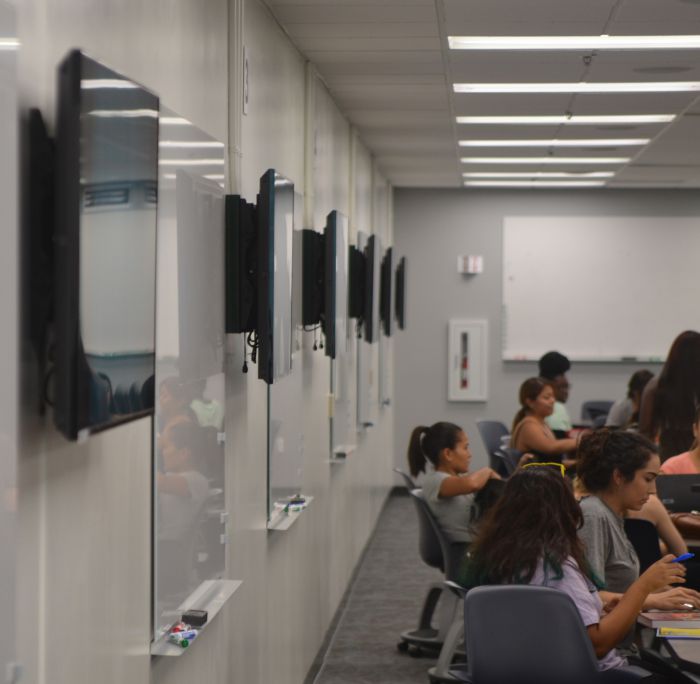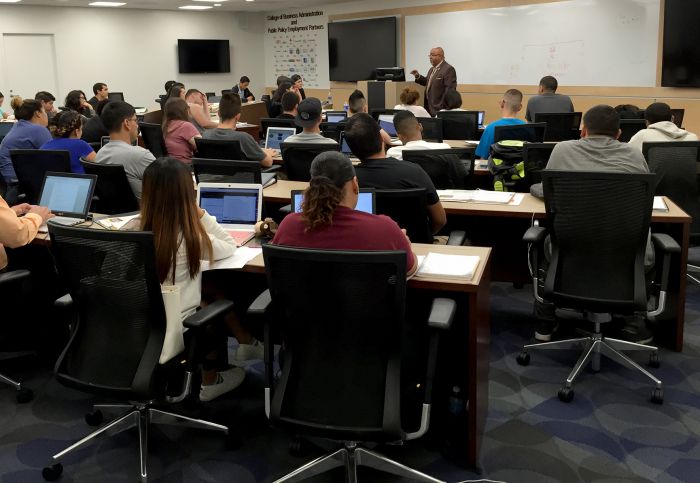
With the installation of three state-of-the-art active learning classrooms (ALC) this summer at California State University, Dominguez Hills (CSUDH) many students will experience a more collaborative and empowering way of learning, while faculty develop more creative approaches to teaching.
The new ALCs consist of two spacious classrooms in Welch Hall (WH 160 A; WH 160 B) that accommodate a total of 154 students, and a new Case Study Room in the University Library (LIB 5514).

In Welch Hall, the classrooms feature multiple desk groupings, each is configured triangularly and seats up to nine students. The work stations provide students computer access to lesson materials provided by the instructors, and access to shared materials so students may work together on projects.
Along with at-station computers, the students may access the system through their personal digital devices. The rooms are lined with large flat-screen monitors so their projects may be discussed with and presented to the entire class, and each desk grouping has a microphone for students to verbally interact with the class.
“I don’t like students coming to Cal State Dominguez Hills and having old desks to sit at. That’s why the possibility of state-of-the-art learning spaces really got me interested in this project,” said Hamoud Salhi, associate dean in the College of Natural and Behavioral Sciences, who helped lead the research and design process of the ALCs. “This project is not just about changing the classroom environment; it is also about changing how instructors approach teaching.”
Although every instructor has a personal lecture style, students in an ALC will typically work first in groups of three on part of an assignment or an individual project, then combine with others into groups of nine and begin utilizing the tools in the classroom, such as the wall monitors and whiteboards to engage collaboratively in learning, according to Salhi.
The instructor’s work stations, or “control centers,” are located near the middle of the classroom among the students’ work stations.
“The instructors deliver lectures from the control center, but it’s more interactive then that,” said Salhi. “There is plenty of space for the students to interact, and for faculty to go around and examine their work. Each table has one student section leader, and the students get to grade themselves and grade their classmates, which encourages them to work harder on their projects. The students should always be an integral part of the learning and teaching process in the ALCs.”

The research and development of the ALCs was launched by Ellen Junn, provost and vice president of Academic Affairs at CSUDH. Salhi took a team of faculty members, architects and project schedulers to other universities using ALCs to observe several classroom configurations. Much of the inspiration for the Welch Hall classrooms was drawn from ALCs at the University of Minnesota and Cal Poly San Luis Obispo, according to Salhi.
“We are proud to join with many other leading universities across the nation in building innovative, technology-enhanced active learning classrooms for our students and faculty. These cutting-edge classrooms provide an opportunity for our faculty to engage in rich, intense and lively problem-solving classroom interactions where all students communicate and test their knowledge with the support of their peers and faculty,” said Junn. “Research shows that these active learning pedagogies significantly improve student academic motivation, interest, knowledge and course performance, and also result in greater student retention and success. As a campus, our top priority is to provide a high-quality, excellent student-centered learning environment for all of our students and faculty.”
During the summer, 43 faculty members expressed interest in using the new classrooms in Welch Hall. They attended four workshops taught by professors from USC and the University of Minnesota to learn specific ALC teaching techniques and styles. This fall, 24 instructors are teaching approximately 28 sections, according to Salhi.
“About 75 percent of the courses in the ALCs this fall are from the College of Natural and Behavioral Sciences, such as anthropology, political science, sociology and psychology,” said Salhi. “But the classrooms can be used for any kind of instruction. The professors must learn to adjust their mindsets to teach in this way because their lectures should be designed to learn by doing.”
Michael Grimshaw, a CSUDH business management lecturer and founder of the Entrepreneurial Institute @ CSUDH, is teaching two courses in the ALCs this fall: Advanced Entrepreneurship (MGT 495-3), and Small Business Management–Introduction to Entrepreneurship (MGT 412-2).
“We are going through a generational transition from Millennials to GenZ students, and the use of personal and classroom electronics is becoming like breathing–very natural and necessary to our students,” said Grimshaw. “In my two classes my students have felt very special and excited about the opportunity to learn together in this amazing classroom. I think the word will spread quickly among the students that CSUDH is the place to be for their education. I am confident that the outcomes will be increased student persistence and accomplishments.”
Although its configuration is different, the new active learning Case Study Room in the library features most of the hardware, accessories and technological teaching capabilities as the ALCs in Welch Hall.

“This is the first active learning case study room in the region that I’m aware of because case study is usually taught in a very traditional way and setting,” said Joseph Wen, dean of the College of Business Administration and Public Policy. “Our new Case Study Room has Internet capabilities, so anyone who wants to join the discussion from another location may do so. Our live streaming technology enables other entire classes to participate in the discussion in real time. Faculty can also record their lectures and save them on ‘the cloud’ so students may access them later.”
Jon Nissen, project supervisor in CSUDH’s Facilities Services Department, led the management and design of the ALCs in Welch Hall, and worked with an outside contractor to do most of the construction work. The Case Study Room’s construction was led by Facilities Project Supervisor Scott Moreno.
“Jon and Scott did an excellent job on these projects. It was a lot of work that was done in a short amount of time,” said Richard Tetrick, manager of Building Trades services in the Facilities Services Department.
Facilities Services also upgraded a regular classroom this summer in the Natural Sciences and Mathematics building with acoustic panels, new tables, chairs, flooring, whiteboards, pull-down screens and speakers, and two in the Social and Behavioral Sciences building.
Salhi believes the university will learn a lot about how to teach in ALCs this fall, and calls the entire project an “experiment to some extent.”
“We will be doing assessments during the semester. We want to know if teaching in these classrooms really makes a difference, and we do that by looking at the students’ performance,” said Salhi. “This will not test the professors in any way. It’s a very student-centered assessment. We want to know that we are getting it right.”